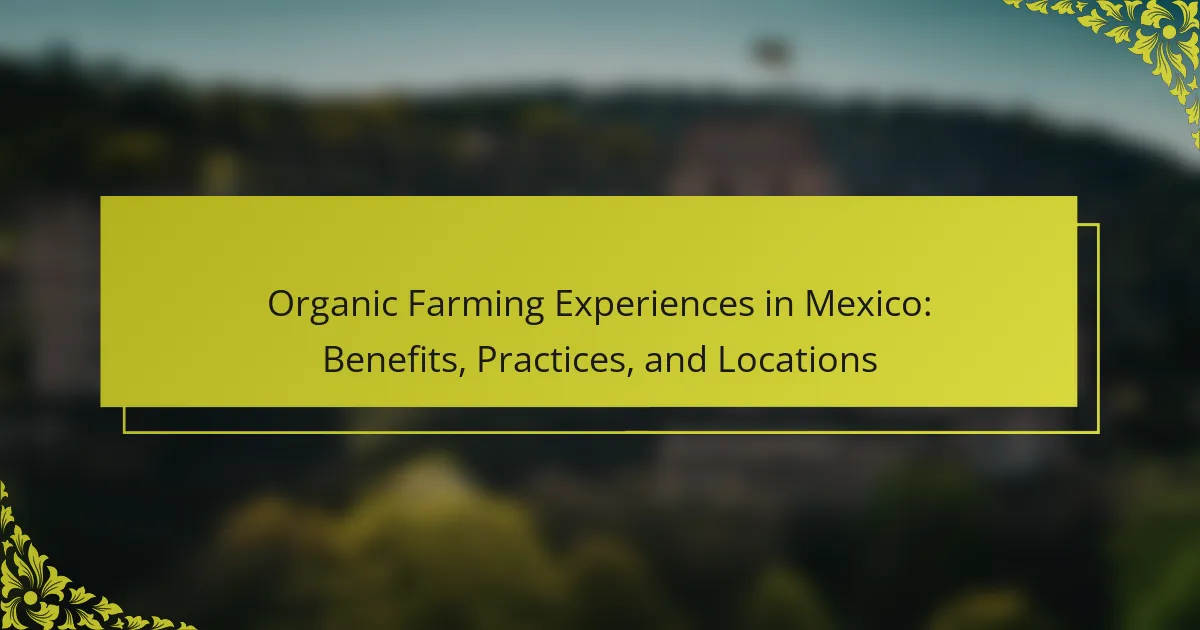Organic farming in Mexico provides significant benefits like improved soil health and enhanced biodiversity while supporting local economies. This article explores prevalent practices such as crop rotation and organic pest management, highlights unique experiences in regions like Oaxaca and Chiapas, and addresses the challenges faced by farmers. Additionally, it discusses how consumers can support organic initiatives through community engagement and advocacy.
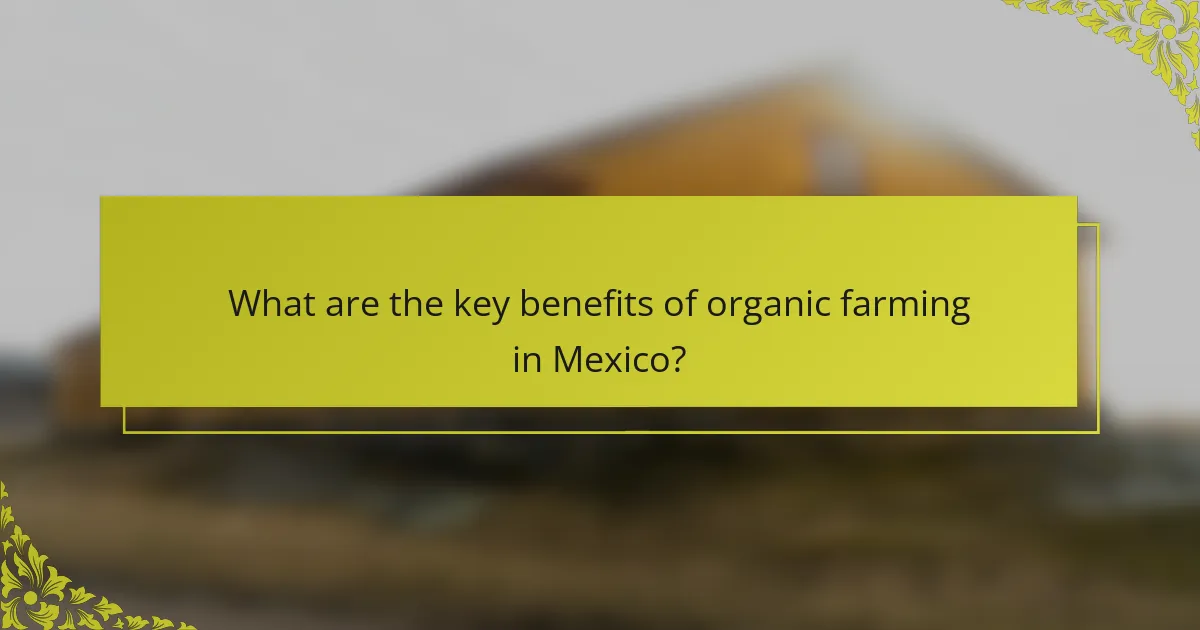
What are the key benefits of organic farming in Mexico?
Organic farming in Mexico offers numerous key benefits, including improved soil health, enhanced biodiversity, and increased resilience to climate change. These practices reduce chemical inputs, promoting healthier ecosystems and safer food for consumers. Organic farms often yield higher prices, benefiting local economies. Additionally, organic farming supports sustainable agricultural practices that preserve natural resources.
How does organic farming impact soil health?
Organic farming enhances soil health by improving its structure, fertility, and biodiversity. Practices such as crop rotation, cover cropping, and composting enrich the soil with organic matter. This leads to better water retention and nutrient availability, ultimately supporting sustainable agricultural systems. In Mexico, organic farms have demonstrated increased microbial activity and reduced erosion, showcasing the positive impact on soil ecosystems.
What are the economic advantages of organic farming for local communities?
Organic farming provides significant economic advantages for local communities in Mexico. It enhances local economies by increasing income through higher market prices for organic products.
Farmers benefit from reduced input costs due to the use of natural fertilizers and pest control methods. As a result, organic farming promotes sustainable practices that lead to long-term soil health and productivity.
Additionally, organic farming creates job opportunities in farming, processing, and distribution. This diversification strengthens local economies and fosters community resilience.
In summary, organic farming not only boosts individual farmer income but also contributes to broader economic stability in local communities.
How does organic farming contribute to biodiversity?
Organic farming enhances biodiversity by promoting diverse ecosystems and sustainable practices. It encourages the growth of various plant species, which supports wildlife habitats and improves soil health. Organic methods reduce chemical inputs, allowing for a more balanced ecosystem. For instance, organic farms in Mexico often incorporate crop rotation and polyculture, fostering resilience against pests and diseases. This approach not only benefits local flora and fauna but also contributes to the overall ecological balance.
What health benefits are associated with consuming organic products?
Consuming organic products offers numerous health benefits, including improved nutrition and reduced exposure to harmful chemicals. Organic farming practices enhance soil health and biodiversity, leading to more nutrient-dense crops. Studies indicate that organic fruits and vegetables often contain higher levels of antioxidants and vitamins. Additionally, organic products may lower the risk of chronic diseases due to the absence of synthetic pesticides and fertilizers.
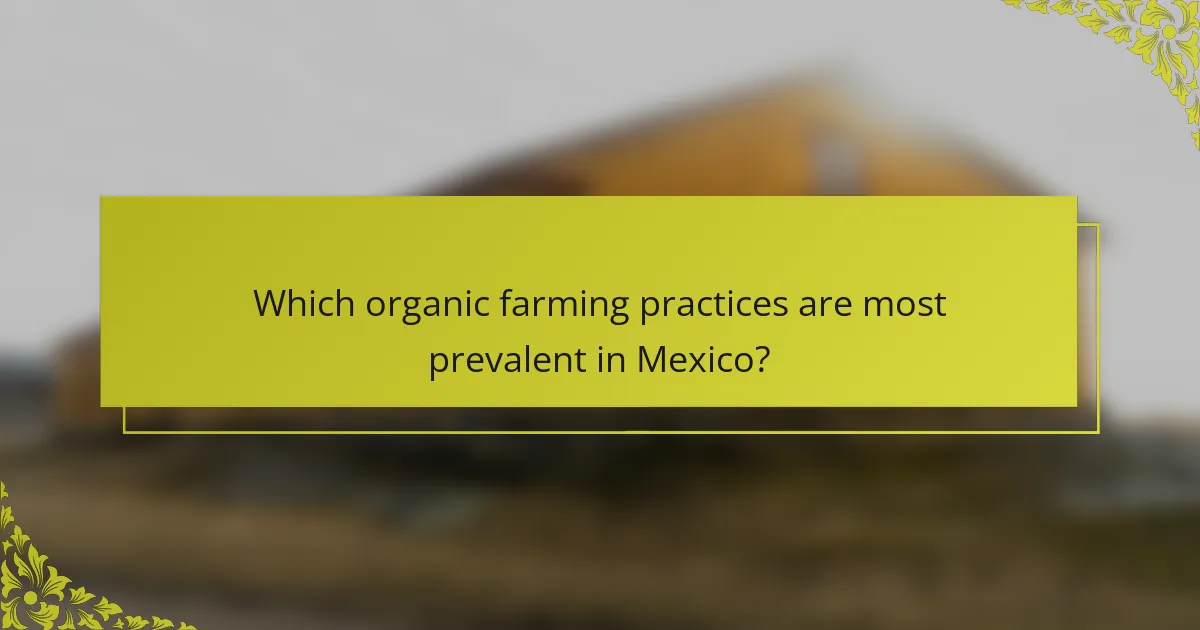
Which organic farming practices are most prevalent in Mexico?
Organic farming practices prevalent in Mexico include crop rotation, intercropping, and organic pest management. These methods enhance soil health, promote biodiversity, and reduce chemical use. Additionally, agroforestry is gaining traction, combining agriculture with forest conservation. Organic certification and local market access further support these practices, fostering sustainable agriculture.
How do crop rotation and companion planting enhance organic farming?
Crop rotation and companion planting significantly enhance organic farming by improving soil health and increasing biodiversity. Crop rotation prevents soil depletion and interrupts pest cycles. Companion planting fosters beneficial relationships between plants, enhancing nutrient uptake and pest resistance. These practices lead to healthier crops and higher yields in organic farming systems.
What role does composting play in organic agriculture?
Composting is essential in organic agriculture as it enhances soil health and fertility. It provides a rich source of nutrients, improves soil structure, and promotes biodiversity. In Mexico, composting practices contribute to sustainable farming by recycling organic waste, reducing dependence on chemical fertilizers, and improving crop yields. This method aligns with the principles of organic farming, fostering an ecosystem that supports healthy plant growth while minimizing environmental impact.
Which pest management techniques are commonly used in organic farming?
Common pest management techniques in organic farming include crop rotation, biological control, and the use of natural pesticides. These methods promote ecological balance and reduce reliance on synthetic chemicals. Crop rotation disrupts pest life cycles, while biological control utilizes natural predators to manage pest populations. Natural pesticides, derived from plants or minerals, offer effective alternatives without harming beneficial organisms.
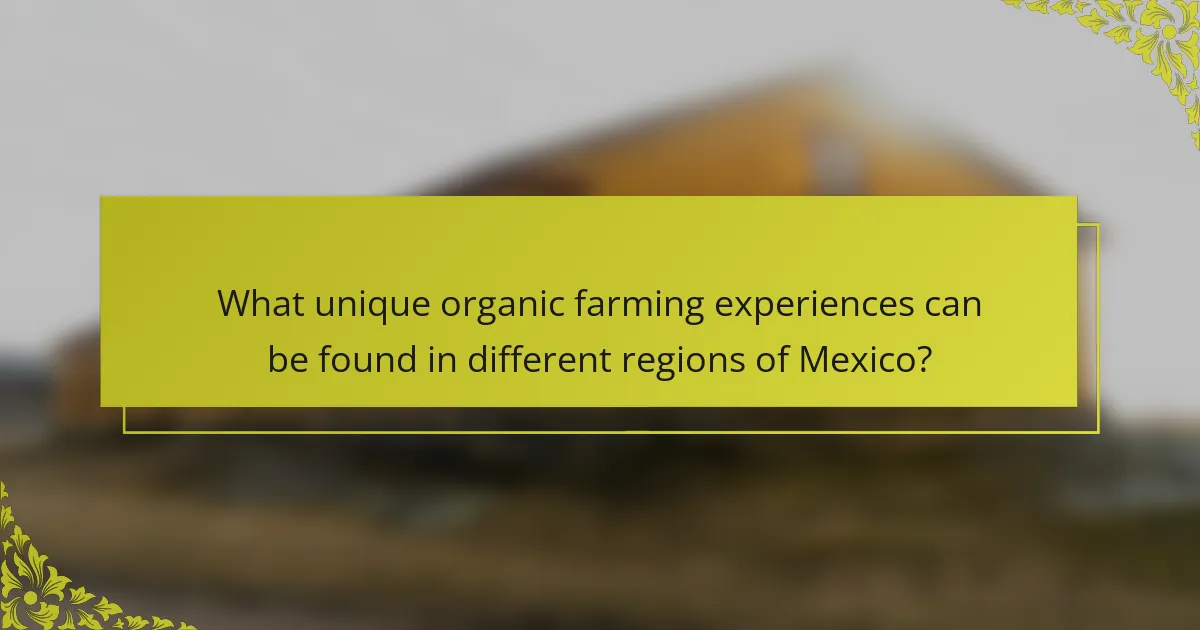
What unique organic farming experiences can be found in different regions of Mexico?
Unique organic farming experiences in Mexico include agroecotourism in Oaxaca, regenerative farming workshops in Chiapas, and permaculture tours in Yucatán. Each region offers distinct practices that enhance sustainability and community engagement. Oaxaca’s rich biodiversity supports traditional methods, while Chiapas focuses on soil health and biodiversity. Yucatán emphasizes water conservation techniques, showcasing a variety of organic produce. These experiences not only promote environmental awareness but also connect visitors with local cultures and sustainable practices.
How do cultural influences shape organic farming practices in Oaxaca?
Cultural influences significantly shape organic farming practices in Oaxaca by integrating traditional methods with modern techniques. Local communities prioritize sustainability, biodiversity, and cultural heritage, resulting in unique farming approaches. Practices often include crop rotation, intercropping, and the use of native seeds, reflecting ancestral knowledge. This blend enhances soil health and promotes ecological balance, demonstrating the region’s commitment to preserving its environmental and cultural identity.
What are the distinctive features of organic farming in the Yucatán Peninsula?
Organic farming in the Yucatán Peninsula is characterized by sustainable practices, biodiversity, and local community involvement. This farming method emphasizes soil health, using organic fertilizers and crop rotations. Unique features include the cultivation of indigenous crops like achiote and the use of traditional Mayan agricultural techniques. Rarely, some farms incorporate agroforestry systems that enhance ecosystem services. The region’s rich biodiversity supports pest control and pollination, contributing to healthier yields.
Which organic farms in Chiapas offer immersive experiences for visitors?
Several organic farms in Chiapas offer immersive experiences for visitors. Notable options include Finca Argovia, which provides farm tours and workshops on sustainable practices, and Finca La Isla, known for its coffee production and guided tasting sessions. Visitors can engage in hands-on activities, learn about organic farming methods, and enjoy the beautiful landscapes. These experiences enhance understanding of local agriculture and promote eco-tourism in the region.
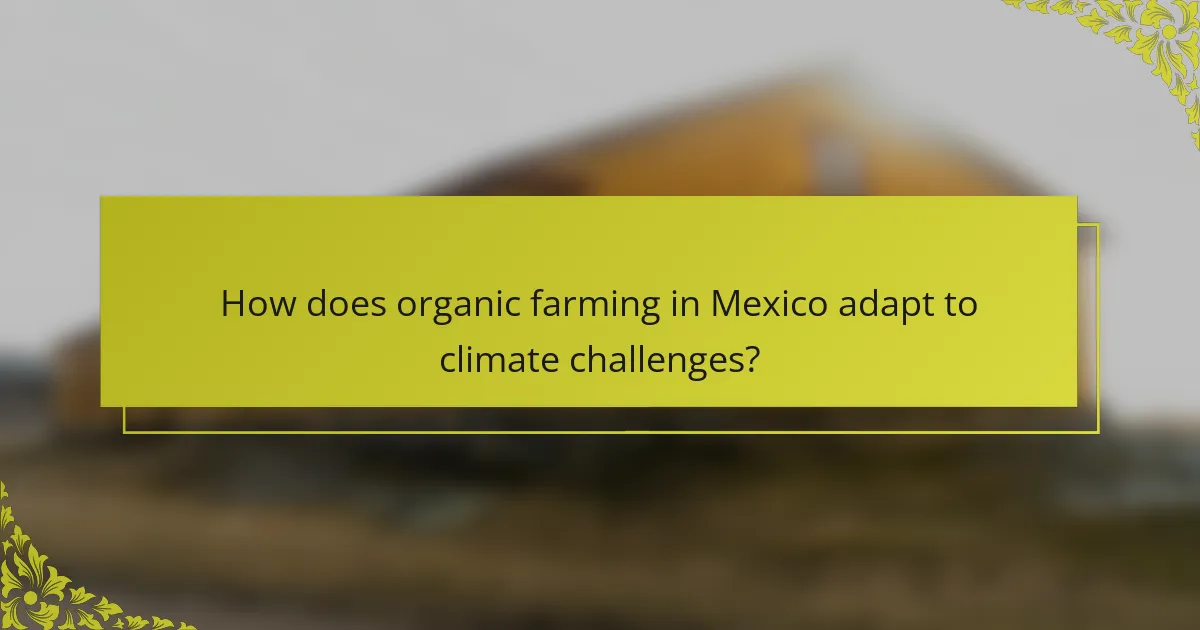
How does organic farming in Mexico adapt to climate challenges?
Organic farming in Mexico adapts to climate challenges through innovative practices and resilience strategies. Farmers implement crop rotation, organic pest control, and soil conservation techniques to enhance biodiversity and improve soil health. These methods help mitigate the effects of droughts and extreme weather. Additionally, many organic farms are located in regions that benefit from microclimates, allowing for a diverse range of crops. By focusing on sustainable practices, organic farmers contribute to environmental health while ensuring food security in the face of climate change.
What innovative techniques are being used to conserve water in organic farming?
Innovative techniques for conserving water in organic farming include rainwater harvesting, drip irrigation, and soil moisture management. These methods enhance water efficiency and promote sustainable practices.
Rainwater harvesting captures and stores rainfall for irrigation, reducing reliance on groundwater. Drip irrigation delivers water directly to plant roots, minimizing evaporation and runoff. Soil moisture management involves monitoring and maintaining optimal moisture levels, ensuring plants receive adequate hydration without waste.
These practices are particularly beneficial in regions like Mexico, where water scarcity is a significant challenge. By implementing these techniques, organic farmers can improve crop yields while conserving vital water resources.
How do farmers address pest challenges in a changing climate?
Farmers in Mexico address pest challenges in a changing climate through integrated pest management and organic practices. They utilize crop rotation, companion planting, and natural predators to reduce pest populations. Organic farming experiences highlight the benefits of enhancing biodiversity and soil health, which improve resilience against pests. Specific locations in Mexico, such as Oaxaca and Chiapas, showcase successful organic farming initiatives that adapt to climate variability.
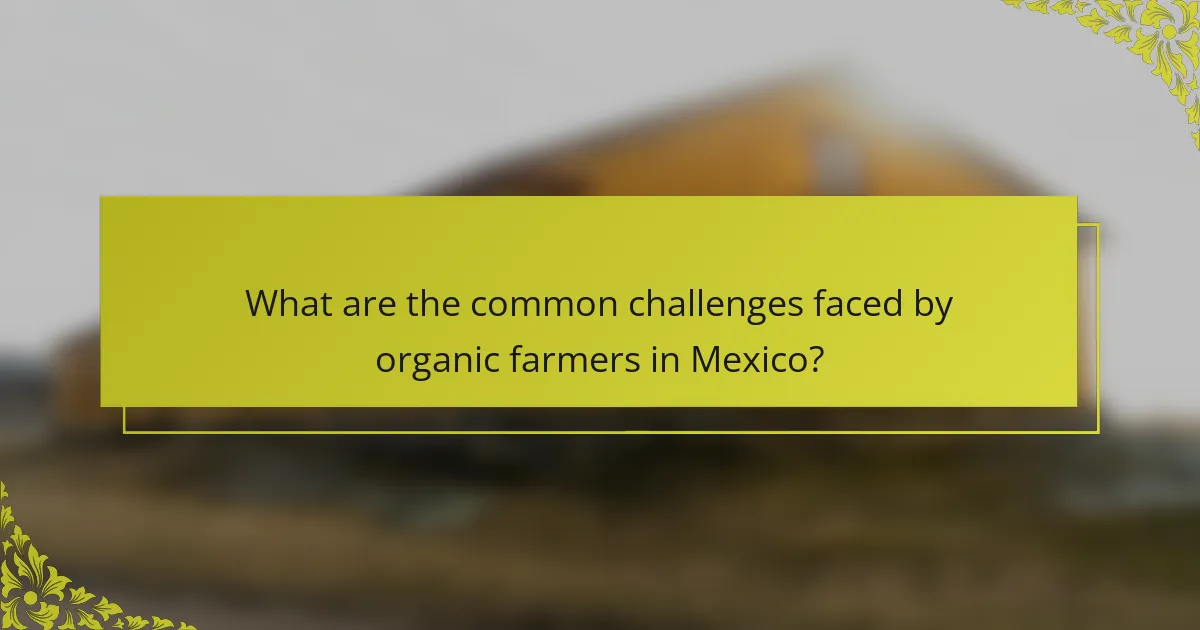
What are the common challenges faced by organic farmers in Mexico?
Organic farmers in Mexico face challenges such as limited access to resources, pest management issues, and market fluctuations. Additionally, they encounter difficulties in obtaining organic certification and navigating bureaucratic regulations. These obstacles hinder their productivity and profitability, impacting the growth of organic farming in the region.
How do market access issues affect organic farmers?
Market access issues significantly hinder organic farmers in Mexico by limiting their ability to reach consumers. These challenges include regulatory barriers, high certification costs, and inadequate infrastructure. As a result, many organic farmers struggle to compete with conventional agriculture. The lack of market access can lead to reduced income and hinder the growth of the organic sector. Addressing these issues is crucial for the sustainability and expansion of organic farming in the region.
What are the regulatory hurdles for organic certification in Mexico?
Organic certification in Mexico faces several regulatory hurdles, including complex bureaucratic processes and strict compliance standards. Producers must navigate multiple government agencies, which can lead to delays and increased costs. Additionally, there is a lack of uniformity in certification requirements across regions, complicating the process further. The need for extensive documentation and adherence to specific agricultural practices can also pose challenges for small-scale farmers.
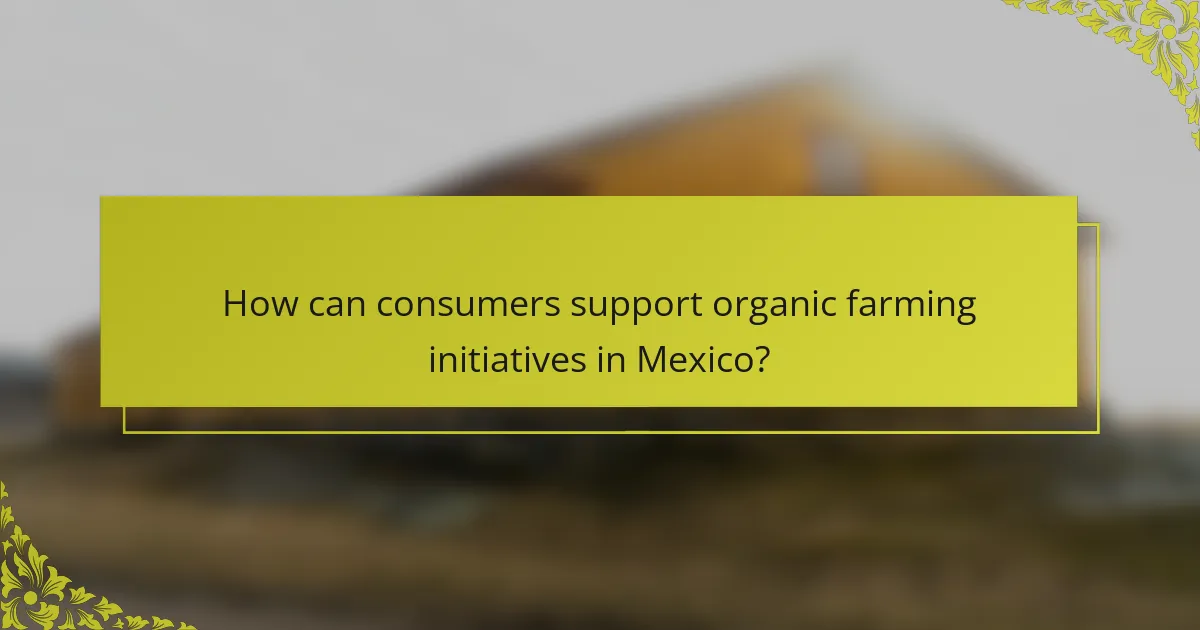
How can consumers support organic farming initiatives in Mexico?
Consumers can support organic farming initiatives in Mexico by purchasing organic products and participating in community-supported agriculture programs. Engaging with local farmers’ markets fosters direct relationships and encourages sustainable practices. Volunteering on organic farms provides hands-on experience and promotes awareness of organic methods. Advocating for policies that support organic farming can influence local agricultural practices. Additionally, educating others about the benefits of organic farming creates a broader support network.
What are the best practices for buying organic produce?
To buy organic produce effectively, consider sourcing from local farmers’ markets, verifying certifications, and understanding seasonal availability. Prioritize freshness and flavor by selecting items that are in season. Engage with farmers to learn about their practices, ensuring they follow organic standards. Additionally, inspect produce for quality, looking for vibrant colors and firmness.
How can individuals get involved in local organic farming movements?
Individuals can engage in local organic farming movements by participating in community-supported agriculture (CSA) programs, volunteering on organic farms, or joining local agricultural cooperatives. These actions foster connections with local farmers and promote sustainable practices.
Participating in workshops and educational programs enhances knowledge of organic farming techniques. Many organizations in Mexico offer training sessions focusing on permaculture, crop rotation, and soil health.
Visiting local farmers’ markets supports organic farmers and provides access to fresh produce. This direct interaction helps consumers understand the benefits of organic farming and encourages sustainable consumption.
Social media platforms and local community boards often announce events related to organic farming, including farm tours and volunteer opportunities. Engaging with these resources amplifies awareness and participation in organic farming initiatives.
What are the common mistakes to avoid when transitioning to organic farming?
Common mistakes to avoid when transitioning to organic farming include inadequate soil preparation, neglecting pest management, and overlooking market research. Farmers often underestimate the importance of building healthy soil, which is foundational for organic practices. Failing to implement effective pest control strategies can lead to crop losses. Additionally, not understanding consumer demand can result in unsold produce. Prioritizing these aspects enhances the chances of success in organic farming.
